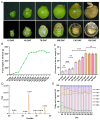The Biosynthesis Pattern and Transcriptome Analysis of Sapindus saponaria Oil
- PMID: 38999621
- PMCID: PMC11244568
- DOI: 10.3390/plants13131781
The Biosynthesis Pattern and Transcriptome Analysis of Sapindus saponaria Oil
Abstract
The Sapindus saponaria (soapberry) kernel is rich in oil that has antibacterial, anti-inflammatory, and antioxidant properties, promotes cell proliferation, cell migration, and stimulates skin wound-healing effects. S. saponaria oil has excellent lubricating properties and is a high-quality raw material for biodiesel and premium lubricants, showing great potential in industrial and medical applications. Metabolite and transcriptome analysis revealed patterns of oil accumulation and composition and differentially expressed genes (DEGs) during seed development. Morphological observations of soapberry fruits at different developmental stages were conducted, and the oil content and fatty acid composition of the kernels were determined. Transcriptome sequencing was performed on kernels at 70, 100, and 130 days after flowering (DAF). The oil content of soapberry kernels was lowest at 60 DAF (5%) and peaked at 130 DAF (31%). Following soapberry fruit-ripening, the primary fatty acids in the kernels were C18:1 (oleic acid) and C18:3 (linolenic acid), accounting for an average proportion of 62% and 18%, respectively. The average contents of unsaturated fatty acids and saturated fatty acids in the kernel were 86% and 14%, respectively. Through the dynamic changes in fatty acid composition and DEGs analysis of soapberry kernels, FATA, KCR1, ECR, FAD2 and FAD3 were identified as candidate genes contributing to a high proportion of C18:1 and C18:3, while DGAT3 emerged as a key candidate gene for TAG biosynthesis. The combined analysis of transcriptome and metabolism unveiled the molecular mechanism of oil accumulation, leading to the creation of a metabolic pathway pattern diagram for oil biosynthesis in S. saponaria kernels. The study of soapberry fruit development, kernel oil accumulation, and the molecular mechanism of oil biosynthesis holds great significance in increasing oil yield and improving oil quality.
Keywords: Sapindus saponaria; biodiesel; fatty acid; key enzyme genes; lipid metabolism; oil biosynthesis; soapberry saponin; transcriptome analysis; triacylglycerol; woody oil plant.
Conflict of interest statement
Author Kezhai sheng is employed by Hunan Soapberry Agroforestry Development Co., Ltd. The company Hunan Soapberry Agroforestry Development Co., Ltd. had no role in the design of the study; in the collection, analyses, or interpretation of data; in the writing of the manuscript, or in the decision to publish the results. The remaining authors declare that the research was conducted in the absence of any commercial or financial relationships that could be construed as a potential conflict of interest.
Figures





Similar articles
-
Transcriptome analysis of metabolic pathways associated with oil accumulation in developing seed kernels of Styrax tonkinensis, a woody biodiesel species.BMC Plant Biol. 2020 Mar 18;20(1):121. doi: 10.1186/s12870-020-2327-4. BMC Plant Biol. 2020. PMID: 32183691 Free PMC article.
-
Identification of genes associated with the biosynthesis of unsaturated fatty acid and oil accumulation in herbaceous peony 'Hangshao' (Paeonia lactiflora 'Hangshao') seeds based on transcriptome analysis.BMC Genomics. 2021 Feb 1;22(1):94. doi: 10.1186/s12864-020-07339-7. BMC Genomics. 2021. PMID: 33522906 Free PMC article.
-
Transcriptome Analysis of Genes Involved in Fatty Acid and Lipid Biosynthesis in Developing Walnut (Juglans regia L.) Seed Kernels from Qinghai Plateau.Plants (Basel). 2022 Nov 23;11(23):3207. doi: 10.3390/plants11233207. Plants (Basel). 2022. PMID: 36501246 Free PMC article.
-
Regulatory mechanisms of fatty acids biosynthesis in Armeniaca sibirica seed kernel oil at different developmental stages.PeerJ. 2022 Oct 4;10:e14125. doi: 10.7717/peerj.14125. eCollection 2022. PeerJ. 2022. PMID: 36213508 Free PMC article.
-
Metabolome and Transcriptome Analysis Reveals the Transcriptional Regulatory Mechanism of Triterpenoid Saponin Biosynthesis in Soapberry (Sapindus mukorossi Gaertn.).J Agric Food Chem. 2022 Jun 15;70(23):7095-7109. doi: 10.1021/acs.jafc.2c01672. Epub 2022 May 31. J Agric Food Chem. 2022. PMID: 35638867
Cited by
-
Genetic diversity and adaptive evolutionary history of Sapindus in China: insights from whole-genome resequencing of 100 representative individuals.Plant Biotechnol J. 2025 Jul;23(7):2485-2500. doi: 10.1111/pbi.70058. Epub 2025 Mar 30. Plant Biotechnol J. 2025. PMID: 40159695 Free PMC article.
References
-
- Wang L.X., Liu J.M., Xu Y.Y., Zhao G.C., Wang X., Rui X., Jia L.M. The correlation between economic traits of soapberry fruit and environmental factors. Chin. J. Ecol. 2021;40:373–380. doi: 10.13292/j.1000-4890.202102.030. (In Chinese) - DOI
-
- Zhao G.C., Gao Y.H., Gao S.L., Xu Y.Y., Liu J.M., Sun C.W., Gao Y., Liu S.Q., Chen Z., Jia L.M. The Phenological Growth Stages of Sapindus mukorossi According to BBCH Scale. Forests. 2019;10:462. doi: 10.3390/f10060462. - DOI
-
- Chakraborty M., Baruah D.C. Production and characterization of biodiesel obtained from Sapindus mukorossi kernel oil. Energy. 2013;60:159–167. doi: 10.1016/j.energy.2013.07.065. - DOI
LinkOut - more resources
Full Text Sources
Miscellaneous

